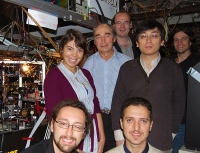
[2009-10-23] Russian-American phycisist Vitaly Efimov, theoretical father of Efimov-states, is currently at the University of Innsbruck. He is visiting the research group that proved his predictions experimentally in an international first 35 years after Efimov made the prediction: In 2006 the team of Wittgenstein awardee Rudolf Grimm observed an Efimov state in an ultracold gas of caesium atmoms.
It is one of the big stories that go down in scientific history: In Russia in 1970, a phycisist found an astoundingly simple answer for a very complicated problem. He speculated about the behaviour of three quantum bodies interacting with each other. While the interaction between two bodies can easily be calculated, the observation of the behaviour of three interacting bodies poses a bigger problem in physics. Vitaly Efimov, however, predicted that three particles would enter into a bound state (called trimer) due to their quantum mechanical properties, whereas a two-body interaction would be absent. What is even more astounding: When the distance between the particles is increased by factor 22.7, an infinite number of Efimov states is possible. According to the theorist, this phenomenon is universal in character and can be applied for particles in the atomic nucleus and is observable for molecular interactions alike. In the beginning, the scientific community was skeptical about these ideas; for a long time an experimental proof was not produced.
35 years after Vitaly Efimov had published his theoretical ideas, the Innsbruck research team of Rudolf Grimm and Hanns-Christoph Nägerl were able to prove these quantum states experimentally. They used an ultracold gas of caesium atoms that forms a Bose-Einstein condensate at temperatures close to the absolute zero. By using a magnetic field, they could tune the interaction strength between the particles and, thus, created the conditions for a bound Efimov three-body state. The Efimov state was observed indirectly through a three-body recombination loss (loss of particles). For the first time, Vitaly Efimov is now visiting the Innsbrucker laboratory, where his predictions were proven experimentally.
”In the meantime, after our successful experiment, a whole new field of work has been developed,“ says Rudolf Grimm enthusiastically. ”A growing number of international research teams have started to experiment with Efimov states.“ The researchers from Innsbruck have also continued with their experiments and, for the first time, have proven Efimov states also between a single atom and a diatomic particle. In addition, in March they observed four-body states that are closely tied to Efimov states. Few-body physics raises questions that have engaged the cleverest minds of the natural sciences to look for solutions. Even today highly sophisticated methods and an enormous numerical computing effort are needed to solve the highly complex questions. ”Experiments to better understand Efimov states are to bring scientists closer to their goal of finding simple laws for complex relationships between several interacting bodies,“ says Prof. Grimm.
In the 1990s, Vitaly Efimov emigrated from Russia to the USA. He has been Professor of Physics and has been teaching at the University of Washington, Seattle. After the experimental breakthrough of the research team in Innsbruck, his research has now generated strong interest on an international scale. An international meeting to Efimov states in Rome brought Vitaly Efimov back to Europe. In Innsbruck a small symposium will take place during his visit. National junior scientists are reporting on their findings to Efimov states at the University of Innsbruck.